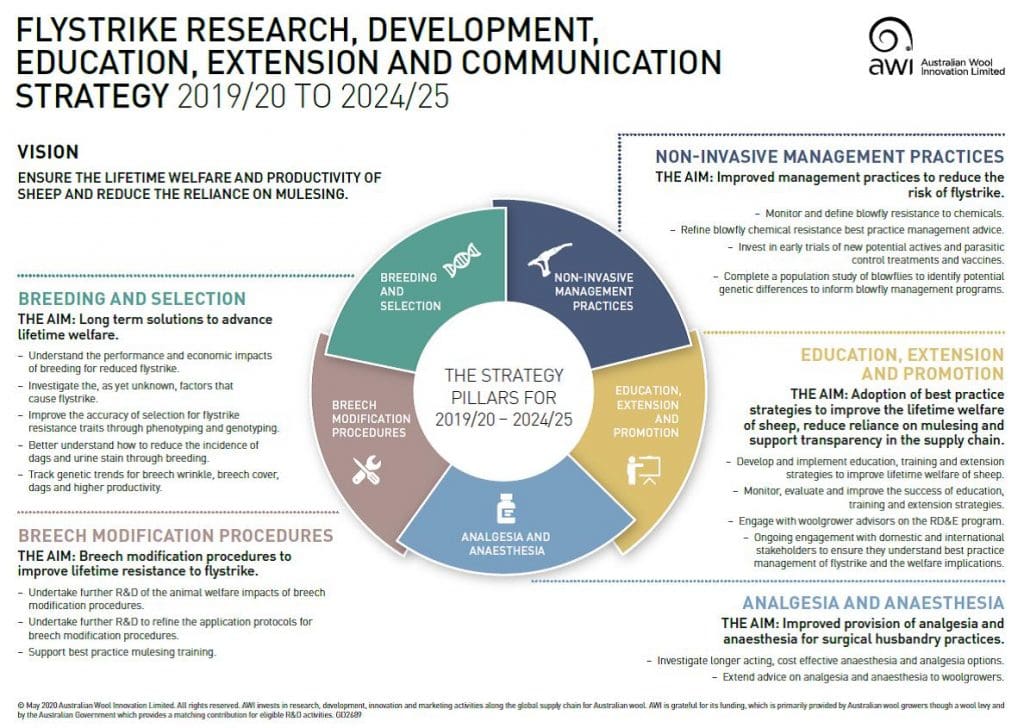 AUSTRALIA’S main wool grower bodies claim the industry’s levy-funded body has released a five-year strategy for flystrike research, development, education, extension and development without consulting them on the strategy’s detail.
AUSTRALIA’S main wool grower bodies claim the industry’s levy-funded body has released a five-year strategy for flystrike research, development, education, extension and development without consulting them on the strategy’s detail.
Australian Wool Innovation last week released details of its ‘Flystrike research, development, education, extension and communication Strategy 2019/20 to 2024/25′ in its ‘Beyond The Bale’ publication that is sent to all shareholders.
The strategy’s vision is to ‘Ensure the lifetime welfare and productivity of sheep and reduce the reliance on mulesing’ with aims and actions under five key areas.
The strategy’s aims and actions included breech modification procedures to improve lifetime resistance to flystrike, supporting best practice mulesing training and investigating longer acting, cost-effective pain relief options.
However, peak grower body WoolProducers Australia and the Australian Wool Growers Association have told Sheep Central that AWI did not consult with the groups before releasing the five-year strategy.
Representative of both bodies have also said the strategy was not discussed with them during meetings of AWI’s Woolgrower Industry Consultation Panel or the secondary Woolgrower Consultation Group.
Sheep Central sent a series of questions on the strategy to AWI chair Colette Garnsey last week, including whether WPA and AWGA were consulted. An AWI spokesperson replied that “growers and groups representing them have been consulted” on the strategy, but did not detail which groups were consulted, nor when or where.
WPA not consulted – Storey

WoolProducers president Ed Storey
However, WPA president Ed Storey today maintained that WPA was not consulted about the five-year strategy despite commitments last from AWI to improved consultative processes.
Mr Storey said WPA was consulted on AWI’s 2019-20 to 2022-23 strategic planning process early last year and made a lengthy submission on the plan, which included a small section on breech flystrike programs.
AWI’s 108-page 2019-20 to 2022-23 strategic plan barely mentioned breech flystrike (in the sheep health and welfare section), Mr Storey said.
“One of our key recommendations was point number 3: AWI should consult with growers to seek more detail on prioritisation of investment across the programs and activities outlined in the draft strategic plan.
“The three-year strategic plan as it is now lacks a lot of detail around this stuff and we called for consultation on that about when those details were developed,” he said.
“This five-year AWI breech flystrike strategy has obviously fallen out of that.”
Mr Storey said a key response from AWI was that it had undertaken a significant review of its consultation activities with a focus on a new consultation model to build effective, respectful and meaningful consultation with grower representative bodies through the WICP and the WCG.
“A key deliverable for the new groups will be identifying R&D priorities to inform AWI and to guide AWI’s strategic annual operating and investment plans.
“This hasn’t happened,” he said.
“The WICP and the WCG were certainly not consulted on the development and the detail of this particular (five-year) strategic plan.”
Mr Storey said he is not sure why the flystrike strategy is over five years.
“In light of preparing a 10-year strategic plan for the industry, I think it would have been wiser to wait.
“I think we need as an industry to more broadly think about alternatives to mulesing, we’ve invested a lot of money…” he said.
“I think if we are going to continue down that path the whole strategy about how we engage with our customers and bring them with us on that on any potential alternatives, needs to be done before rather than after … we need to bring them with us on the journey of alternatives,” Mr Storey said.
“There is no doubt following the National Wool Declaration review it is apparent that many supply chain partners view mulesing and alternatives to be the same.”
Mr Storey said blowflies represent a unique risk to Australian wool growers, but to invest in mulesing alternatives the industry needed to bring its customers along and maximise the chances of any alternative being considered favourably in the marketplace.
He said any strategic plan on flystrike management needed a stronger measurable genetic element.
A notable omission in the five-year strategy was an emphasis on AWI informing growers of the market trends and preferences for non-mulesed wool and wool from sheep mulesed with pain relief.
Mr Storey said AWI is ideally placed to provide this market intelligence to growers on market demand for different types of wool.
“Information that growers don’t have and don’t get from AWI is that market information about demand for different metrics around our wool.”
He said “there is certainly a great difference between what we hear from AWI and what we hear from exporters and brokers who are actually physically moving the wool” in the non-mulesed market.
“As an RDC to which we all pay a compulsory levy they have no right to modify information and edit things; they’ve got to tell it like it is.”
Not a market-driven strategy – AWGA

AWGA director Robert Ingram
AWGA director Robert Ingram said neither AWGA nor the WICP were ever consulted about the five- year flystrike strategy released in “Beyond the Pale (Bale)”.
“I don’t know where the consultation took place, but I know it never went to WICP to get our input and feedback.
Apart from an action of tracking genetic trends for breech wrinkle, cover, dags and higher productivity, Mr Ingram noted that the strategy had “nothing on genetics,” while it supported mulesing training among contractors.
“It is not a market-driven strategy.”
Five-year strategy is an update of earlier strategies – AWI
The AWI spokesperson said AWI has existing investments in flystrike vaccine and genetics (MLP) out to FY 2022 for the former and FY2024 for the latter.
This Flystrike RDEEC strategy 2019/20-2024/25 is an update of the Breech Flystrike Strategy 2017/18-2021/22, the spokesperson said.
“These strategies are five years long which provides better guidance for significant (value and industry need) projects that span the three year AWI Strategic Plans.”
The spokesperson said the Flystrike RDEEC Strategy 2019/20-2024/25 and can be updated once informed by a 10-year strategic plan or a new board. The 10-year strategy is an internal document, but a summary is available on wool.com
When asked why the five-year strategy did not include in its Education, Extension and Promotion section – despite referring to supporting transparency in the supply chain – engaging and informing growers of market preferences for non-mulesed and mulesed with pain relief wool, AWI said AWEX provides free web access to the premiums and discounts information it collects.
“AWI hasn’t included a formal operational investment to duplicate the role of AWEX in the current or previous flysrike strategy; however, AWI does have a wool.com information page on the NWD and also links to AWEX.
The spokesperson said AWI also produced information on planning for a non-mulesed Merino enterprise and provided information on AWEX’s latest NWD update.
“Given the Flystrike RDEEC Strategy to FY25 is a fluid document, AWI can highlight this element within its extension approach if needed by industry; however, AWI would likely need to also highlight all the other elements of its extension approach which may take the summary of the strategy to two pages,” the AWI spokesperson said.
The spokesperson said the one-page strategy summary document is the public face of an internal AWI document which provides AWI and Woolmark staff with a broad understanding of diverse grower needs and diverse market needs.
“AWI communicates regularly with growers on industry trends.”
No funds allocated to future breech modification R&D
The AWI spokesperson said no funds have been allocated to future breech modification R&D projects under the current AWI Strategic Plan as no project proposals have been received that satisfy market failure, co-investment or acceptable scientific risk profile.
“AWI’s investment focus is now primarily on vaccine and genetics through MLP because budget constraints at present do not allow AWI to consider changing our proposal assessment criteria.”
However, the spokesperson said it is responsible for AWI to remain open to receiving project proposals on breech modification as innovations could lessen the welfare impact of any current or future intervention.
“It would be up to research to demonstrate improved welfare from that innovation in breech modification.”
The spokesperson said the question as to whether further grower expenditure on breech modification R&D was consistent with market trends and supply chain demands would be assessed at the time AWI received a project proposal that passed all other investment criteria.
“At present it is known that all wool sells, including wool from mulesed sheep with analgesia and anaesthaesia and from sheep that have had a liquid nitrogen process, therefore AWI can’t exclude the area of research in breech modification from its strategy.”
The spokesperson said AWI has updated the out-of-date Mulesing Accreditation Manual and published the Plan Prepare Conduct Best Practice Lamb Marking Training Guide https://www.wool.com/globalassets/wool/sheep/research-publications/welfare/improved-breech-flystrike-management/plan-prepare-conduct-best-practice-lamb-marking-training-guide.pdf .
“AWI has no current investment in training on mulesing or lamb marking; however, AWI recognises that growers may still need to mules while they are breeding more natural resistance into their sheep.”


Mulesing doesn’t prevent body strike, yet fly on the breech is preventable with good management — crutching, monitoring, genetics, drenching etc.
I’m a shearer who has travelled around Australia and witnessed non-mulesed wrinkly Merinos not have fly strike with good management and also poorly-managed mulesed sheep with flystrike.